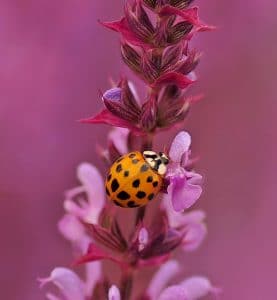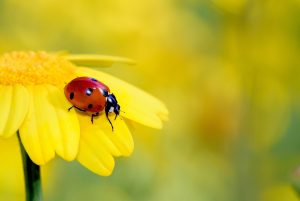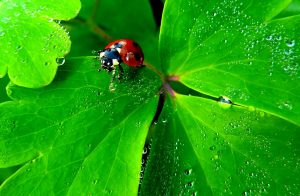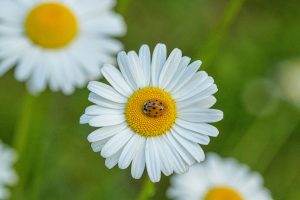They’re cute, colourful little beetles that eat pests who destroy vegetable farms and gardens, but beyond that, what do you really know about ladybugs? I sat down with a ladybug recently to get answers to the age-old question, “what should you know about ladybugs?” What this ladybug revealed might surprise you.
Maria (M): Ladybug, thank you for taking the time to sit and talk with me today. My readers are anxious to know all about you and we are all looking forward to getting beyond your shell of cuteness and perhaps even explore your dark side.
Ladybug (LB): Yes. My fans want to know more, I get that. I’m not on social media so I agreed to this interview to set the record straight on a few things.
Ladybug Names from Around the World
M: First, how do you like to be addressed? What name do you prefer?
LB: I have many names throughout the world and I like them all! Lady Beetle, Mary’s Beetle, Flower Lady, Good News, Ladybird, Our Lady’s Little Hen, Gold Cow, God’s Cow, Gold Bird, Lord God’s Little Fatty, Gold Bird, Insect of Fortune, Little Mary, and of course, Ladybug. By the way, the United States is the only place we are called ladybugs. And, we are not all ladies. The “lady” in our name refers to the Virgin Mary. The song Polka Dotty has the name story and a call-out of some of our names from around the world. There’s also a Polka Dotty lyric video to watch with the larva, I mean, kids.
Age Spots – Can You Tell the Age of a Ladybug by the Number of Spots?
M: It is considered rude in some cultures to ask someone’s age. Is it true that you can tell a ladybug’s age by the number of spots on the shell (elytra)?

LB: Hahahaha, that was a rumour spread long ago by an ancient prankster ladybug. There is no truth to it. Sometimes we have no spots at all. Sometimes we have lots of spots. Some of us have stripes not spots!
We have short lives, often less than a year. That would be almost a dot? Hahaha. The number of dots on my shell can tell you what species I am but that’s not the purpose of the spots. The spots and our bright colours are a message to those who might find us appetizing. That message is not something a polite ladybug like myself would repeat but I can tell you it’s not nice. Those who ignore the message understand it most clearly.
M: So what you’re saying is we will never see “chocolate covered ladybugs” as a holiday gift idea.
LB: Oh, dear no, that’s for approval seeking ants and grasshoppers. So desperate. (LB shakes her head) But this talk is making me hungry.
What do Ladybugs Eat?
M: And what’s on today’s menu? What do ladybugs eat?
LB: Oooh, All-I-Can-Eat Aphids! I found a cozy, uncrowded place down the road that has my favorites – aphids and mealybugs. There are vegans among us, those that eat only plants, but I’m carnivorous like a lot of ladybugs. How I stay so fit is beyond me because I can chow down! I have several friends who each ate about 5,000 aphids in their lifetime. It takes a little work, but it’s very doable.

I’m not judging, but…some of us eat other ladybugs. It’s the harlequin ladybird. They eat our eggs and larvae and bring parasites that kill us, the native species. It’s becoming a problem for us in several places around the world. I’d rather not talk about it but you can learn more in this article about the harlequin ladybird and how they are reducing biodiversity. Whew! I just got all sciency…and that makes me hungry.
I like spider mites and whiteflies. I hear that makes me popular with some gardeners. And I love fruits, especially berries, and figs and peaches and cherries and plums! A balanced and varied diet includes some pollen, nectar and fungi. Don’t knock it – if you’re too picky, you may not survive. I also eat eggs. I like eggs of all kinds of insects. There’s nothing like fresh eggs to start the day, do you agree? Food is my Thing!
M: And that’s why farmers and gardeners LOVE you! Now, usually you go where the food is, you have wings and you fly to the food; but, sometimes you’re boxed and shipped to stores where gardeners purchase you and take you home. Talk to me about what that’s like for you and your families.
How do you Release Ladybugs in Your Garden?
LB: Ladybug Trafficking. You know, they promise us infinite food. They say we’ll be so appreciated and loved and the kids will squeal with delight and, and, and….Aaaargrgh! It’s just not true! We are kept in a cold, dark place but we don’t sleep like humans, so we are just on pause, in fact, when we hibernate it’s called diapause. Then a family buys us and we know we’re about to get all that food we were promised. It’s very exciting. See, they don’t always feed us before hitting the ladybug pause button so we are boxed up cold and hungry. When we go home with our new owners, we wake up hungry.
And where is the food? I’ve heard about so many of us being dumped into a sunny, hot, dry patch of barely grown plants. There’s no water, no shelter, no food and the kids are trying to catch us, so we have to go. Adios! Thanks for nothing! We take off in hangry flight to find a place that already has our favorite bugs, on plants we can hide in and make whoopee on. We rarely get what we were promised.

M: I’m sorry to hear that. Tell our readers exactly how you would like to be introduced to their gardens.
LB: Thank you, yes! First, make sure that when you buy us, we are the right type for your climate and environment. Keep it native. Only buy us from sellers who have fed us before they put us on pause (they call it “preconditioned”). Don’t release hangry ladybugs then have nothing to feed them!!! Let us out in the morning while dew is on the grass and plants, or mist your garden in the evening and let us out then. We need some coolness and hydration, hello. Please mulch your garden so we have a place to hide. Take us to the spot where the juicy aphids are and we will take care of them for you. It’s not a hide-n-seek game. Show us the aphids! And use your brain, do not let us out in the winter, we will only hibernate. In fact, when we see fewer and fewer aphids, that tells us it’s time to make whoopee then hibernate. That’s right, a ladybug is expected to “sleep” after doing it.
Plants that Attract Ladybugs to Your Garden
Also on our wish list is that you plant some nasturtiums, dill, calendula, cilantro, maybe some sunflowers and well, there’s lots of plants that welcome us to your garden. We love bright flowers!

M: I see. That’s good to know. Ladybug, I can’t tell you how much I’ve enjoyed talking with you today. Your candor is much appreciated. I believe you have set the record straight on a lot of ladybug mythunderstandings. See Fen on your way out for your gift basket of aphids, raisins and fungus.
LB: You get me. Bye!
